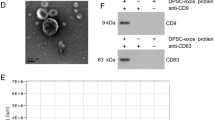Summary
The aim of this study was to investigate the mechanism of deposition of extracellular matrix induced by TGF-β1 in skeletal muscle-derived stem cells (MDSCs). Rat skeletal MDSCs were obtained by using preplate technique, and divided into four groups: group A (control group), group B (treated with TGF-β1, 10 ng/mL), group C (treated with TGF-β1 and anti-connective tissue growth factor (CTGF), both in 10 ng/mL), and group D (treated with anti-CTGF, 10 ng/mL). The expression of CTGF, collagen type-I (COL-I) and collagen type-III (COL-III) in MDSCs was examined by using RT-PCR, Western blot and immunofluorescent stain. It was found that one day after TGF-β1 treatment, the expression of CTGF, COL-I and COL-III was increased dramatically. CTGF expression reached the peak on the day 2, and then decreased rapidly to a level of control group on the day 5. COL-I and COL-III mRNA levels were overexpresed on the day 2 and 3 respectively, while their protein expression levels were up-regulated on the day 2 and reached the peak on the day 7. In group C, anti-CTGF could partly suppress the overexpression of COL-I and COL-II induced by TGF-β1 one day after adding CTGF antibody. It was concluded that TGF-β1 could induce MDSCs to express CTGF, and promote the production of COL-I and COL-III. In contrast, CTGF antibody could partially inhibit the effect of TGF-β1 on the MDSCs by reducing the expression of COL-I and COL-III. Taken together, we demonstrated that TGF-β1-CTGF signaling played a crucial role in MDSCs synthesizing collagen proteins in vitro, which provided theoretical basis for exploring the methods postponing skeletal muscle fibrosis after nerve injury.
Similar content being viewed by others
References
Wynn TA. Common and unique mechanisms regulate fibrosis in various fibroproliferative diseases. J Clin Invest, 2007,117(3):524–529
Tomasek JJ, Gabbiani G, Hinz B, et al. Myofibroblasts and mechano-regulation of connective tissue remodeling. Nat Rev Mol Cell Biol, 2002,3(5):349–363
Friedman SL. Mechanisms of disease: mechanisms of hepatic fibrosis and therapeutic implications. Nat Clin Pract Gastroenterol Hepatol, 2004,1(2):98–105
Schuppan D, Ruehl M, Somasundaram R, et al. Matrix as a modulator of hepatic fibrogenesis. Semin Liver Dis, 2001,21(3):351–372
Phan SH. The myofibroblast in pulmonary fibrosis. Chest, 2002,122(6):286S–289S
Hagood JS, Olman MA. Muscle fatigue. Am J Respir Cell Mol Biol, 2007,37(5):503–506
Li Y, Huard J. Differentiation of muscle-derived cells into myofibroblasts in injured skeletal muscle. Am J Pathol, 2002,161(3):895–907
Cao B, Zheng B, Jankowski RJ, et al. Muscle stem cells differentiate into hematopoietic lineages but retain myogenic potential. Nat Cell Biol, 2003,5(7):640–646
Massagué J, Blain SW, Lo RS. TGFbeta signaling in growth control, cancer, and heritable disorders. Cell, 2000,103(2):295–309
Derynck R, Akhurst RJ. Differentiation plasticity regulated by TGF-beta family proteins in development and disease. Nat Cell Biol, 2007,9(9):1000–1004
David A. Brenner. Molecular pathogenesis of liver fibrosis. Trans Am Clin Climatol Assoc, 2009,120(2):361–368
MS Wilson, TA Wynn. Pulmonary fibrosis: pathogenesis, etiology and regulation. Mucosal Immunol, 2009,2(2): 103–121
Brown RD, Ambler SK, Mitchell MD, et al. The cardiac fibroblast: therapeutic target in myocardial remodeling and failure. Annu Rev Pharmacol Toxicol, 2005,45(4): 657–687
Desmoulière A, Darby IA, Gabbiani G. Normal and pathologic soft tissue remodeling: role of the myofibroblast, with special emphasis on liver and kidney fibrosis. Lab Invest, 2003,83(12):1689–1707
Meng FB, Chen JH, Li J, et al. Role of transforming growth factor-β1 in the process of fibrosis of denervated skeletal muscle. J Huazhong Univ Sci Technol [Med Sci], 2011,31(1):77–82
Shi-Wen X, Leask A, Abraham D. Regulation and function of connective tissue growth factor/CCN2 in tissue repair, scarring and fibrosis. Cytokine Growth Factor Rev, 2008,19(2):133–144
Rachfal AW, Brigstock DR. Structural and functional properties of CCN proteins. Vitam Horm, 2005,70(1): 69–103
Fan WH, Pech M, Karnovsky MJ. Connective tissue growth factor (CTGF) stimulates vascular smooth muscle cell growth and migration in vitro. Eur J Cell Biol, 2000,79(12):915–923
Chen CC, Chen N, Lau LF. The angiogenic factor induces adhesive signaling primary human skin fibroblasts. J Biol Chem, 2001,276(13):10 443–10 452
Paradis V, Dargere D, Bonvoust F, et a1. Effects and regulation of connective tissue growth factor on hepatic stellate cells. Lab Invest, 2002,82(6):767–774
Nie MB, Chen ZB, Hong GX. Influence of transforming growth factor β1 on denervated mouse muscle derived stem cell producing connective tissue growth factor at different time points in vitro. Zhongguo Xiufu Chongjian Waike Zazhi (Chinese), 2007,21(7):557–560
Grotendorst GR, Okochi H, Hayashi N. A novel transforming growth factor beta response element controls the expression of the connective tissue growth factor gene. Cell Growth Differ, 1996,7(4):469–480
Author information
Authors and Affiliations
Corresponding author
Additional information
This project was supported by the National Natural Science Foundation of China (No. 30872627).
Rights and permissions
About this article
Cite this article
Chen, Yh., Peng, Yl., Wang, Y. et al. TGF-β1-induced synthesis of collagen fibers in skeletal muscle-derived stem cells. J. Huazhong Univ. Sci. Technol. [Med. Sci.] 33, 238–243 (2013). https://doi.org/10.1007/s11596-013-1104-0
Received:
Published:
Issue Date:
DOI: https://doi.org/10.1007/s11596-013-1104-0




